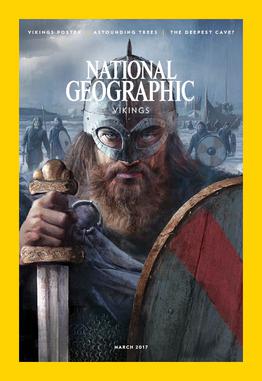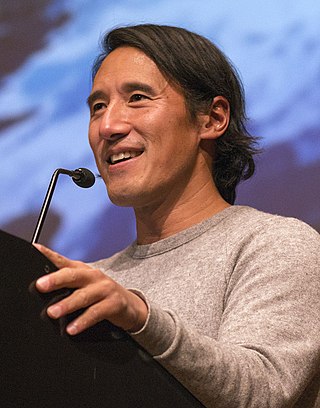
National Geographic is an American monthly magazine published by National Geographic Partners. The magazine was founded in 1888 as a scholarly journal, nine months after the establishment of the society, but is now a popular magazine. In 1905, it began including pictures, a style for which it became well-known. Its first color photos appeared in the 1910s. During the Cold War, the magazine committed itself to present a balanced view of the physical and human geography of countries beyond the Iron Curtain. Later, the magazine became outspoken on environmental issues.

James Francis "Frank" Hurley was an Australian photographer and adventurer. He participated in a number of expeditions to Antarctica and served as an official photographer with Australian forces during both world wars. He was the official photographer for the Australasian Antarctic Expedition and the Imperial Trans-Antarctic Expedition of 1914–16.
The Antarctica Service Medal (ASM) was established by the United States Congress on July 7, 1960, under Public Law 600 of the 86th Congress. The medal was intended as a military award to replace several commemorative awards which had been issued for previous Antarctica expeditions from 1928 to 1941. With the creation of the Antarctica Service Medal, the following commemorative medals were declared obsolete;

Kenneth Brower is an American writer known for his natural environment writings. His published works include articles with the National Geographic Society, The Atlantic Monthly, Smithsonian, Audubon, and several other periodicals.

Henryk Arctowski Polish Antarctic Station is a Polish research station on King George Island, off the coast of Antarctica.

Frans Lanting is a Dutch National Geographic photographer, author and speaker.

Eric Cheng is a Taiwanese American entrepreneur, professional photographer, and Emmy-nominated executive producer specializing in virtual reality, underwater photography, and aerial imaging. He is Head of Immersive Media at Facebook Reality Labs.

Wildlife photography is a genre of photography concerned with documenting various forms of wildlife in their natural habitat.
David Doubilęt is an underwater photographer known primarily for his work published in National Geographic magazine, where he is a contributing photographer and has been an author for 70 feature articles since 1971. He was born in New York City and started taking photos underwater at the young age of 12. He started with a Brownie Hawkeye in a rubber anesthesiologist's bag to keep the water out of the camera. He lived with his family in New York City and spent summers in Elberon New Jersey exploring the Atlantic. He later worked as a diver and photographer for the Sandy Hook Marine Laboratories in New Jersey and spent much of his youth in the Caribbean as a teenage dive instructor in the Bahamas where he found his motivation to capture the beauty of the sea and everything in it. His wife is the photographer Jennifer Hayes.

Jimmy Chin is an American professional mountain athlete, photographer, skier, film director, and author.

Brian Skerry is an American photojournalist and film producer specializing in marine life and ocean environments. Since 1998 he has been a contributing photographer for National Geographic magazine with more than 30 stories to his credit, including 6 covers. In 2021 Skerry won a Primetime Emmy Award for his role as producer in the miniseries, Secrets of the Whales.

Fiona Ayerst is a wildlife photographer based in South Africa notable for underwater photography. She has swum with many species of shark, photographed them, including the macropredator tiger shark and the massive but tamer whale shark. Her images have won awards in numerous photo competitions. She writes for several magazines, and works as an editor for Beyond Blue magazine. She is a proponent of protecting sharks and ocean environments. Her images have appeared in magazines and newspapers worldwide, such as Time magazine, as well as on magazine covers and coffee table books featuring wildlife photography. She won South Africa's 2003 Wildlife Photographer of the Year. She gave a TED talk in 2012 titled My journey into water. She is a director of Africa Media.
Wesley C. Skiles was an American cave diving pioneer, explorer, and underwater cinematographer. Skiles lived in High Springs, Florida.

RV Hero was a research vessel that operated in Antarctica for the National Science Foundation between 1968 and 1984. She was decommissioned in 1984 and partially sank in 2017 after a storm in Bay Center, Washington.
Charles "Flip" Nicklin is a nature photographer best known for his underwater photographs of whales. He has been called "one of the world's leading whale photographers."

Valerie May Taylor AM is an Australian conservationist, photographer, and filmmaker, and an inaugural member of the diving hall of fame. With her husband Ron Taylor, she made documentaries about sharks, and filmed sequences for films including Jaws (1975).
Scott Portelli is an underwater photographer and nature photographer from Mosman, New South Wales, Australia. Portelli won numerous national and international nature photography awards between 2015 and 2020 and is best known for his underwater images of whales and dolphins.

Robert Dale, known as Bob Dale, was an American aircraft pilot for the United States Navy from 1942 to 1966; and a pilot for the National Science Foundation from 1967 to 1975. For his efforts as a pilot in Antarctica as Lieutenant Commander, USN, and part of the Antarctic Operation Deep Freeze (1959–1960), Dale Glacier was named after him by the Advisory Committee on Antarctic Names (US-ACAN) in 1963.
Simon J Pierce is a marine biologist and conservationist known for discovering, studying, and protecting large marine animals such as whale sharks and manta rays. He is the co-founder and principal scientist of the Marine Megafauna Foundation.


















